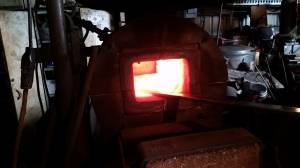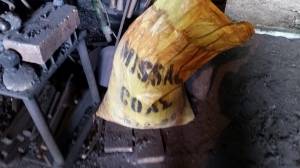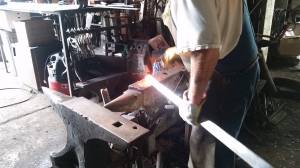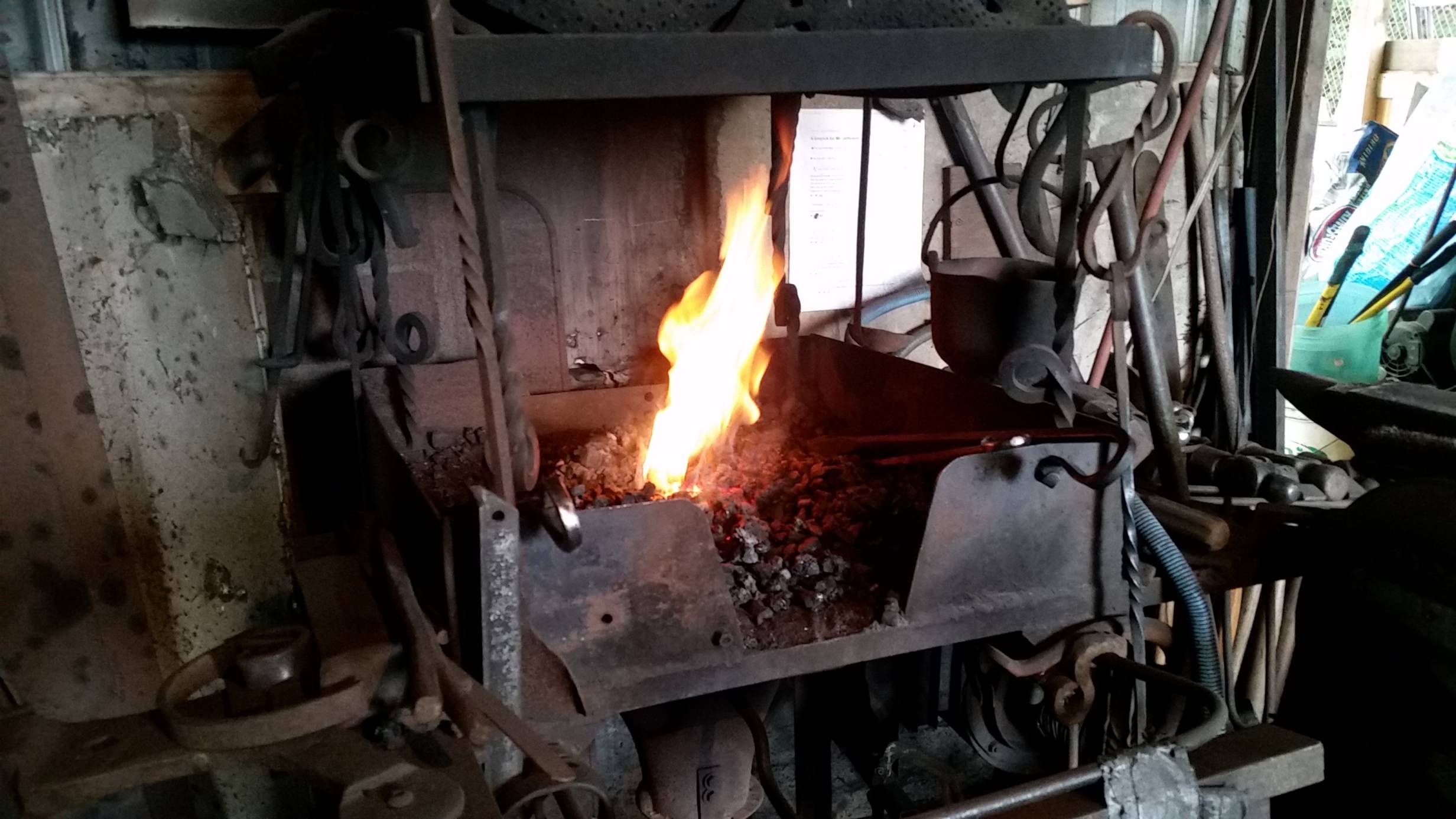Anyone here in Champaign-Urbana knows what it’s like to be a bustling hive of activity tucked away between planting fields and behind corn stalks like a demon in a Stephen King novel. On the far Eastern edge of Urbana, Dean Rose’s shop is similarly nestled away, surrounded by agriculture. But in a way, his shop seems much more at home between the rows than a computer science or chemistry lab. You see, Mr. Rose is Urbana’s blacksmith.
Getting to Dean Rose’s workshop isn’t difficult: you just get on Windsor (County Road 1400 N) and drive west. I was a little concerned about finding the shop; on the outskirts of Urbana at this time of year, driving down Windsor feels a little like making a run on the exhaust vent of the first Death Star. High walls of corn, slight tufts of yellow silk popping out periodically among the leaves, make the road into a sort of channel. That’s neat rather than scary until other vehicles (apparently with very important places to be) blow past you going 30 miles per hour faster than the posted limit.
Mr. Rose’s workshop is a small outbuilding by the beautiful home he shares with his wife. Outside are various pieces of metal – scrap, defective pieces, and works-in-progress – covered by an assortment of tarps to protect them from the elements. The scene is something that Mr. Rose says you always see outside of blacksmiths’ shops.
“A blacksmith’s shop is always a work in progress,” he said. “There’s always something to be moved from one side of the shop to the other or something to be improved. The work is never done.”
Nonetheless, Dean Rose seems to have found a comfortable routine. When I arrived, he was busy working on some iron railings, his main line of business.
Mr. Rose was practicing blacksmithing as a hobby for years, but back before officially becoming a blacksmith, he was working in the last Texas Oil Boom. Then, when oil busted (as it is wont to do), he realized he needed to make a change, and in 1993, he officially “hung out the shingle”.
“About ten years ago, I got the website ‘ironhandrail.com’, and started selling on ebay. I was surprised nobody else was doing it.”
The hand rails, which come in lengths ranging from 2 feet to 13 feet, start as bars of raw iron. Dean taps threaded holes into the bars, heats and hammers them into shape, bolts on additional parts, and then finishes and paints them with a zinc-containing primer to defend against corrosion. The hand rails ship with malleable brackets, and since they are only primed, the customer has the freedom to choose exactly what color and type of finish they want the rails to have.
The process of creating a hand rail is labor-intensive and is deceptively complex. It requires an understanding of the tools and the steel which can’t be easily learned from a book. For instance, while Dean said that his two furnaces (one coal and the other gas) burn at about 2,400 degrees Fahrenheit, he reminded me that the number is an estimate only.
 “It’s a lot less about the number and a lot more about the color. You want to heat the metal over a yellow heat, maybe sometimes a white heat.”
“It’s a lot less about the number and a lot more about the color. You want to heat the metal over a yellow heat, maybe sometimes a white heat.”
Blacksmithing has always been a skill that was heavy on the art, and even this matter of the temperature is an example of that. Early blacksmiths had no thermometers – no way to tell the exact temperature of the fire. Surely the first blacksmiths learned through trial-and-error before passing on their wisdom.
And when one looks at Dean’s work around CU, like the archway in Lincoln Square for Urbana’s Market at the Square, the Engineering Hall lamp posts, or the “Tootsie” sculpture in West Side Park, the artistry allowed to (or required of) the blacksmith is quite apparent.
When most people think of artists, they imagine someone standing before a white canvas, brush and palette in hand, dropping happy trees next to a bubbling brook. Or maybe they imagine someone sitting at a pottery wheel, their fingers softly guiding wet clay into a beautiful, ornate form. I doubt that many people imagine a bearded man holding a glowing metal rod and beating it into shape with a heavy mallet. But that’s really what blacksmithing is: a blend of tech and art.
And much like painting or sculpting, the tools of the trade haven’t changed much over time. As mentioned before, Dean uses both a coal-burning furnace and a gas-fueled one. The coal furnace is hand-made (by a friend of Dean’s) and burns coal  obtained from Missal Grain and Coal near Streator, Illinois. While there is coal production closer to Urbana, Dean uses the coal from Missal because it produces a high heat with less ash and contains less sulfur. In general, it’s a more efficient coal for blacksmithing.
obtained from Missal Grain and Coal near Streator, Illinois. While there is coal production closer to Urbana, Dean uses the coal from Missal because it produces a high heat with less ash and contains less sulfur. In general, it’s a more efficient coal for blacksmithing.
A blacksmith’s most iconic tool is the anvil, a large piece of metal usually with a  horn on one end and a flat surface on top. It is used as a shaper, a surface upon which to hammer, and sometimes a platform for other tools. Dean has several anvils stationed about the shop. And for times when a hammer and elbow grease won’t do the job, he has a vintage piece of equipment to make the job easier: a 50 pound power hammer.
horn on one end and a flat surface on top. It is used as a shaper, a surface upon which to hammer, and sometimes a platform for other tools. Dean has several anvils stationed about the shop. And for times when a hammer and elbow grease won’t do the job, he has a vintage piece of equipment to make the job easier: a 50 pound power hammer.
Eye and ear protection donned, Dean carried a piece of glowing steel over to the power hammer and flipped a switch. Motors whirred to life. He smiled at me.
“This one is about a hundred years old!”
And it seems to be doing fine. A power hammer is exactly what you think it is: a giant electric hammer. There is a large (in this case, 50 pound) hammer head attached off-center to a wheel. When a lever (a ring around the base of the tool) is pressed, the tool begins to rotate and periodically drops its hammer onto a base block which functions as an anvil. Anything positioned between the hammer and the anvil is effectively and consistently smashed. The machine reduces the time needed to flatten out the ends of the hand rails, letting Dean get to the shaping step a lot faster, thus increasing his productivity.
Dean keeps both ovens running when he’s working. He keeps a couple of irons in the fires to increase productivity and ensure that he’s not wasting any energy. As one piece is heating to the proper temperature, he can work on the other. He moves at a quick and steady pace that seems rare, even among people as young as I am. Watching him work, you know you’re watching a true artisan, a master of the craft.
Like the blacksmiths of old, Dean’s skills don’t just stop with shaping metal using fire and hammer; he also does some aluminum and bronze casting. This is how he made the Engineering Hall lamp posts mentioned previously. Dean uses the sand casting method, which means he uses a template to form a mold in wet sand and then pours in liquid metal to fill the cavity and create the piece.
In a stroke of “modern meets timeless”, Dean sometimes uses a 3D printer to make shapes that he can use to make the molds. Where blacksmiths of the past would have to carve something out of wood or wax in order to make a mold, Mr. Rose has found that modern technology makes his job significantly easier.
If you’ve got the blacksmithing bug, though, don’t bother contacting Mr. Rose for an apprenticeship.
“I’ve got too many things of my own to do. I’ve got so many ‘honey-do’ projects that I’m behind just based on that. I don’t have the energy to teach someone else the art.”
That isn’t to say that Mr. Rose is doing nothing but making hand rails. He has been comissioned by the Urbana Parks Department to generate new art, new metalwork, and he works on that with as much passion as anything else. And never fear, young wanna-be Wayland Smiths: there are some things you can learn from books, and you can always get started with an oxy-acetelyne torch and a rosebud tip just like Dean Rose did.








